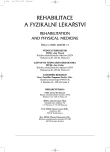Use of Infared Thermography in Hydrotherapy: Effect of Priessnitz Procedures on Changes in Skin Temperatures
Authors:
L. Janský 1; D. Jandová 2; P. Kunc 3; I. Knížková 3; V. Vávra 1
Authors‘ workplace:
Biologická fakulta Jihočeské univerzity, České Budějovice
1; Priessnitzovy léčebné lázně, a. s., Jeseník
2; Výzkumný ústav živočišné výroby, Uhříněves
3
Published in:
Rehabil. fyz. Lék., 13, 2006, No. 1, pp. 3-6.
Category:
Original Papers
Overview
Infared thermography was used to measure the time course of skin temperature changes in subjects immersed singly or repeatedly into the cold water (14 C) up to the knees. The cooling induced a small, but sustained activation of the sympathetic nervous systém, which manifested as a temporal decrease in skin temperature, indicating vasoconstriction. After the initial vasoconstriction subsequent cycles of transient vasodilation occured in most skin areas. The skin bood flow on the head and neck proved to be an exception, since in this areas theskin blood flow was maintained increased permanently. Data indicate thar the action of the sympathetic nervous system on skin blood flow during local cooling is not a generalized phenomenon, but differs in different areas of the body.
Repeated coolings of lower exremities induce a less marked hypothermia in the skin of central areas of the body and greater peripheral hypothermia in hands. The observed changes persisted at least one month after the end of the adaptation procedure. Results indicate that the repeated Priessnitz procedures can induce adaptation, which manifests as decrease in the sympathetic tone in most of the skin blood vessels.
Key words:
infrared thermography, Priessnitz procedures, skin temperatures
Labels
Physiotherapist, university degree Rehabilitation Sports medicineArticle was published in
Rehabilitation & Physical Medicine

2006 Issue 1
Most read in this issue
- Possibilities of Therapeutic Climbing in Physiotherapy
- Cervical Spine in Relationship to Etiology Disorders of Cervical Region
- Clinical Significance of Trigger Point in Acromial Part of Deltoid Muscle
- Significance of Soft Parts in the Origin of Sacroiliac Dysfunctions in Posttraumatic Conditions of Lower Extremities
